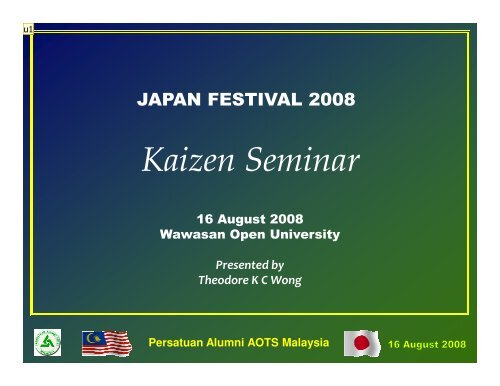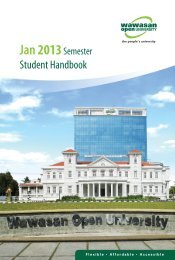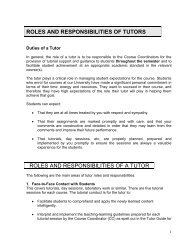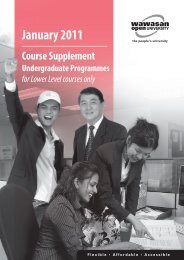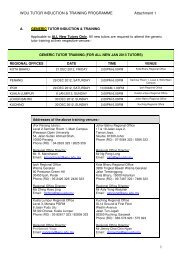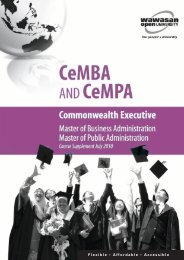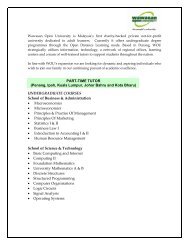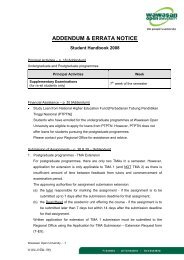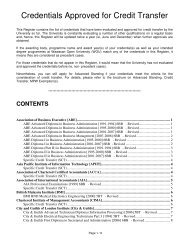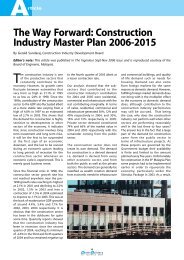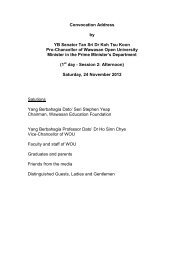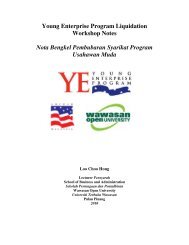Persatuan Alumni AOTS Malaysia - Wawasan Open University
Persatuan Alumni AOTS Malaysia - Wawasan Open University
Persatuan Alumni AOTS Malaysia - Wawasan Open University
Create successful ePaper yourself
Turn your PDF publications into a flip-book with our unique Google optimized e-Paper software.
u1<br />
JAPAN FESTIVAL 2008<br />
Kaizen Seminar<br />
16 August 2008<br />
<strong>Wawasan</strong> <strong>Open</strong> <strong>University</strong><br />
Presented by<br />
Theodore K C Wong<br />
<strong>Persatuan</strong> <strong>Alumni</strong> <strong>AOTS</strong> <strong>Malaysia</strong>
Slide 1<br />
u1 user, 10/8/2008
Japanese Translation<br />
Continual Improvement<br />
<strong>Persatuan</strong> <strong>Alumni</strong> <strong>AOTS</strong> <strong>Malaysia</strong>
Introduction<br />
Masaaki Imai<br />
“KAIZEN, The Key to Japan’s Competitive Success”<br />
The Essence of Kaizen is simple and straight forward.<br />
Kaizen means improvement involving everyone.<br />
Kaizen philosophy<br />
Assures way of life – working, social, home –<br />
deserves to be constantly improved<br />
<strong>Persatuan</strong> <strong>Alumni</strong> <strong>AOTS</strong> <strong>Malaysia</strong>
Introduction<br />
Three functions to happen simultaneously<br />
within organization.<br />
Maintenance<br />
Kaizen<br />
Abolition, Simplication, Alternation<br />
Innovation<br />
<strong>Persatuan</strong> <strong>Alumni</strong> <strong>AOTS</strong> <strong>Malaysia</strong>
Perception<br />
Top Management<br />
Innovation<br />
Middle Management<br />
Kaizen<br />
Supervisors<br />
Maintenance<br />
Workers<br />
<strong>Persatuan</strong> <strong>Alumni</strong> <strong>AOTS</strong> <strong>Malaysia</strong>
In Essence<br />
The Japanese term equates to<br />
forever continuous and gradual improvement.<br />
The approach is Philosophical and Pragmatic<br />
-“technology” built into the job process<br />
- change of method to achieve an objective.<br />
Implemented by middle / lower managers and workers,<br />
encouraged and directed<br />
by the top in Top Down Approach.<br />
<strong>Persatuan</strong> <strong>Alumni</strong> <strong>AOTS</strong> <strong>Malaysia</strong>
Introduction<br />
Encompasses a collection of techniques for<br />
continuously improving performance / productivity<br />
for cost effectiveness, quality and delivery,<br />
without large capital investments<br />
i.e. small change within restriction.<br />
Contains two elements<br />
- improvement / corrective action to change for the better<br />
- ongoing / continuity / repetition<br />
<strong>Persatuan</strong> <strong>Alumni</strong> <strong>AOTS</strong> <strong>Malaysia</strong>
Introduction<br />
Strives to empower the worker<br />
to increase worker satisfaction;<br />
facilitate a sense of accomplishment;<br />
create a sense of pride in one's work.<br />
Kaizen techniques create<br />
a relationship between the worker and the job;<br />
job process becomes a partner<br />
to achieve job objectives.<br />
<strong>Persatuan</strong> <strong>Alumni</strong> <strong>AOTS</strong> <strong>Malaysia</strong>
APS, modifiedTPS<br />
•Customer focused<br />
•People orientated<br />
•Safety Quality Delivery Cost Morale<br />
•Process Orientated<br />
Just in Time<br />
•Takt Time<br />
•One-Piece Flow<br />
•Downstream Pull<br />
SMED<br />
Kanban<br />
3P<br />
Standard Work<br />
•5S<br />
•Visual Management<br />
•Job Instruction<br />
Thinking<br />
•How to think – 12<br />
paradigms<br />
•Reflection – face the facts<br />
•Ideas – Creativity & Craft<br />
Stability<br />
•4M focus<br />
•Demand & volume (heijunka)<br />
•Lonh-term philosophy<br />
Jidoka<br />
•Build in quality<br />
•Harmony of Human<br />
and Machine<br />
Stop the line<br />
5 Why s<br />
Poka Yoke<br />
Kaizen<br />
•Go See<br />
•PDCA<br />
•7 Wastes<br />
Accountability<br />
•Daily, weekly, monthly checks<br />
•Total Involvement<br />
Urgency<br />
•Escalation system<br />
•Speed of response<br />
Leadership<br />
•Zone control<br />
•Teams<br />
<strong>Persatuan</strong> <strong>Alumni</strong> <strong>AOTS</strong> <strong>Malaysia</strong>
We deduce<br />
Kaizen concentrates on improving<br />
processes<br />
rather than achieving certain results<br />
Sugar<br />
Milk<br />
Mint<br />
<strong>Persatuan</strong> <strong>Alumni</strong> <strong>AOTS</strong> <strong>Malaysia</strong>
Basics for Kaizen Implementation<br />
a. Discard conventional fixed ideas and challenge<br />
new idea.<br />
b. Think of how to do it, not why it cannot be done.<br />
Think that you can do it.<br />
c. Do not make excuses, start by questioning<br />
current practices.<br />
d. Correct it right away, if you make mistake. Do<br />
not allow it snowball to big problem.<br />
<strong>Persatuan</strong> <strong>Alumni</strong> <strong>AOTS</strong> <strong>Malaysia</strong>
Basics for Kaizen Implementation<br />
e. Do not spend money for KAIZEN, use your<br />
WISDOM.<br />
f. Wisdom is brought out when faced with<br />
hardship.<br />
g. Ask “WHY” five times and seek root causes.<br />
h. Seek the wisdom of 10 people rather than the<br />
knowledge of one. Two heads are better than<br />
one.<br />
i. KAIZEN ideas are infinite. There is no perfect<br />
work.<br />
j. Do even a little thing.<br />
<strong>Persatuan</strong> <strong>Alumni</strong> <strong>AOTS</strong> <strong>Malaysia</strong>
Process Concept<br />
Input<br />
4M:<br />
•Man<br />
•Machine<br />
•Method<br />
•Material<br />
Process<br />
Kaizen<br />
Output<br />
<strong>Persatuan</strong> <strong>Alumni</strong> <strong>AOTS</strong> <strong>Malaysia</strong>
Kaizen Techniques include<br />
1. Variation Reduction<br />
2. Poka-Yoke (error-proofing)<br />
3. Standardized Work<br />
4. Workplace Organization<br />
5. Process Analysis (waste reduction)<br />
6. Lean/Agile<br />
7. 5S<br />
8. Quality Control Cycle (QCC)<br />
<strong>Persatuan</strong> <strong>Alumni</strong> <strong>AOTS</strong> <strong>Malaysia</strong>
1. Variation Reduction<br />
Every task, job, or activity has a certain amount of<br />
inherent variation or variability.<br />
Reducing the amount of variation in each job, the chance<br />
of error occurring during the job process is reduced.<br />
By introducing “technology” to the situation, the inherent<br />
variation of the activity is reduced.<br />
<strong>Persatuan</strong> <strong>Alumni</strong> <strong>AOTS</strong> <strong>Malaysia</strong>
2. Poka-Yoke (error-proofing)<br />
Poka-yoke are primarily devices<br />
- create a dialogue between the worker and the job.<br />
Inform the worker of the accuracy or suitability of each job<br />
action by way of<br />
physical constraints (symmetry / asymmetry, guide pins)<br />
attributes (size, weight, dimensions, material)<br />
sensors (all types).<br />
<strong>Persatuan</strong> <strong>Alumni</strong> <strong>AOTS</strong> <strong>Malaysia</strong>
<strong>Persatuan</strong> <strong>Alumni</strong> <strong>AOTS</strong> <strong>Malaysia</strong>
<strong>Persatuan</strong> <strong>Alumni</strong> <strong>AOTS</strong> <strong>Malaysia</strong>
<strong>Persatuan</strong> <strong>Alumni</strong> <strong>AOTS</strong> <strong>Malaysia</strong>
<strong>Persatuan</strong> <strong>Alumni</strong> <strong>AOTS</strong> <strong>Malaysia</strong>
<strong>Persatuan</strong> <strong>Alumni</strong> <strong>AOTS</strong> <strong>Malaysia</strong>
3. Standardised Work<br />
Establishing a pattern, a rhythm, or a flow to each job.<br />
May be self-imposed by the worker<br />
enforced by laws (wearing safety goggles, hard hats)<br />
regulations (sound ergonomic practices)<br />
operating standards/procedures.<br />
<strong>Persatuan</strong> <strong>Alumni</strong> <strong>AOTS</strong> <strong>Malaysia</strong>
Comprises three elements :<br />
1. Takt Time - Available time to produce one unit of output<br />
= hours or seconds / shift outputs required / shift<br />
2. Work Sequence - order in which work is performed.<br />
Most efficient way work should be completed and is used<br />
as a safety tool to eliminate unsafe positions during<br />
equipment operation.<br />
3. Standard In-Process Stock - minimum amount of stock<br />
required to continue the sequence of operations.<br />
<strong>Persatuan</strong> <strong>Alumni</strong> <strong>AOTS</strong> <strong>Malaysia</strong>
<strong>Persatuan</strong> <strong>Alumni</strong> <strong>AOTS</strong> <strong>Malaysia</strong>
4. Workplace Organization<br />
Techniques involve keeping the work area clean<br />
using visual structuring to identify where tools<br />
inventory and materials are to be stored<br />
and having work materials positioned for ergonomic<br />
efficiency and worker safety.<br />
Principles of 5S<br />
<strong>Persatuan</strong> <strong>Alumni</strong> <strong>AOTS</strong> <strong>Malaysia</strong>
<strong>Persatuan</strong> <strong>Alumni</strong> <strong>AOTS</strong> <strong>Malaysia</strong>
<strong>Persatuan</strong> <strong>Alumni</strong> <strong>AOTS</strong> <strong>Malaysia</strong>
<strong>Persatuan</strong> <strong>Alumni</strong> <strong>AOTS</strong> <strong>Malaysia</strong>
5. Process Analysis (Waste Reduction)<br />
Focuses on the reduction of non-value added job<br />
components.<br />
Within production system, 67% of the workers’ time is<br />
spent on storage, 25% on handling, 3% on inspection and<br />
only 5% on process or value-added activity.<br />
To increase the amount of time spent on value-added<br />
activity, the storage, handling, and inspection percentages<br />
must be reduced.<br />
<strong>Persatuan</strong> <strong>Alumni</strong> <strong>AOTS</strong> <strong>Malaysia</strong>
Waste<br />
• Waste is non value added<br />
activities.<br />
• Eliminate of waste is not kaizen;<br />
change of method to eliminate<br />
cause of waste is.<br />
<strong>Persatuan</strong> <strong>Alumni</strong> <strong>AOTS</strong> <strong>Malaysia</strong>
Seven Types of Waste<br />
1. Early production*<br />
2. Waiting time<br />
3. Transportation<br />
4. Process<br />
5. Inventory*<br />
6. Non value added motion<br />
7. Product defect and rework*<br />
<strong>Persatuan</strong> <strong>Alumni</strong> <strong>AOTS</strong> <strong>Malaysia</strong>
<strong>Persatuan</strong> <strong>Alumni</strong> <strong>AOTS</strong> <strong>Malaysia</strong>
6. Lean / Agile<br />
Refers to system properties that are :<br />
Simple<br />
Mobile<br />
Adjustable<br />
Reusable<br />
: simple design, simple tools, simple assembly<br />
: portable, lightweight devices<br />
: devices that can quickly and easily reflect<br />
changes in the work environment, the<br />
product, and the product demands<br />
: materials may be reused as products,<br />
processes, or assembly volumes change.<br />
The life of the device may be geared to the<br />
life of the job, and workers may reuse<br />
the components in a new device or system<br />
configuration.<br />
<strong>Persatuan</strong> <strong>Alumni</strong> <strong>AOTS</strong> <strong>Malaysia</strong>
Lean / Agile devices directly address issues of material<br />
handling, storage, and parts presentation / positioning for<br />
the workers.<br />
In this capacity they address the largest components of<br />
waste reduction ; storage and handling.<br />
Lean / Agile devices contribute to good workplace<br />
organization and visual structuring techniques.<br />
<strong>Persatuan</strong> <strong>Alumni</strong> <strong>AOTS</strong> <strong>Malaysia</strong>
<strong>Persatuan</strong> <strong>Alumni</strong> <strong>AOTS</strong> <strong>Malaysia</strong>
<strong>Persatuan</strong> <strong>Alumni</strong> <strong>AOTS</strong> <strong>Malaysia</strong>
<strong>Persatuan</strong> <strong>Alumni</strong> <strong>AOTS</strong> <strong>Malaysia</strong>
<strong>Persatuan</strong> <strong>Alumni</strong> <strong>AOTS</strong> <strong>Malaysia</strong>
Productivity<br />
=<br />
Output<br />
__________________________<br />
Quality, Cost, Time of Delivery<br />
<strong>Persatuan</strong> <strong>Alumni</strong> <strong>AOTS</strong> <strong>Malaysia</strong>
Gemba<br />
Genchi Gembutsu<br />
VISIT and<br />
KNOW what<br />
is there and<br />
what to do<br />
Gemba<br />
vs<br />
MBWA<br />
VISIT and<br />
SEE and<br />
OBSERVE<br />
Workplace where value is added<br />
<strong>Persatuan</strong> <strong>Alumni</strong> <strong>AOTS</strong> <strong>Malaysia</strong>
Impact from Kaizen<br />
1. Improvement in work<br />
2. Saving in energy, material and other resources<br />
3. Improvement in working environment<br />
4. Improvement in machines and processes<br />
5. Improvement in jigs & tools<br />
6. Improvement in office environment<br />
7. Improvement in product quality<br />
8. Ideas for new products<br />
9. Customer satisfaction & customer relation<br />
<strong>Persatuan</strong> <strong>Alumni</strong> <strong>AOTS</strong> <strong>Malaysia</strong>
Kaizen Environment<br />
Everyday - some kind of improvement<br />
Management Activity - Increased Customer<br />
Satisfaction<br />
Quality First, Not Profit First - Prosper if Customer<br />
Satisfied<br />
Freely admit problems and suggest improvements<br />
X-functional system and collaborative approach<br />
towards problem solving<br />
Think process improvement w Mgt. support<br />
<strong>Persatuan</strong> <strong>Alumni</strong> <strong>AOTS</strong> <strong>Malaysia</strong>
Cost Cutting ≈ job cuts<br />
Costs Cutting vs<br />
Cost Management<br />
using cheaper raw materials<br />
Cost Management = optimization of materials flow<br />
alignment and synchronization<br />
of production spread<br />
X-functional system and collaborative approach<br />
towards problem solving<br />
Think process improvement w Mgt. support<br />
<strong>Persatuan</strong> <strong>Alumni</strong> <strong>AOTS</strong> <strong>Malaysia</strong>
Stumbling Blocks<br />
1. Management does not support it – Management drives<br />
the improvement process – require, enable, empower<br />
2. Lack objectives – set objectives with schedules, clear<br />
communication seems to motivate & guide staff – set<br />
goals, monitor, assist, achieve<br />
3. Employees do not know how to – Training and<br />
Education<br />
4. Short term attitude<br />
5. Copy or understand<br />
6. Management not at Gemba<br />
<strong>Persatuan</strong> <strong>Alumni</strong> <strong>AOTS</strong> <strong>Malaysia</strong>
Quality<br />
• Customers set the ultimate criteria for<br />
quality.<br />
• If customers are satisfied, they will<br />
continue to patronize and the company<br />
will continue to survive.<br />
<strong>Persatuan</strong> <strong>Alumni</strong> <strong>AOTS</strong> <strong>Malaysia</strong>
<strong>Persatuan</strong> <strong>Alumni</strong> <strong>AOTS</strong> <strong>Malaysia</strong>
In Summary<br />
Kaizen = to take apart and put back together in a<br />
better way<br />
Applicable to any matter, such as processes,<br />
resources or people<br />
Small steps taken to produce desired process<br />
improvements instead of one big overhaul<br />
Safe way to implement quality<br />
Without human intervention, no process<br />
improvement using Kaizen<br />
<strong>Persatuan</strong> <strong>Alumni</strong> <strong>AOTS</strong> <strong>Malaysia</strong>
Instil discipline of going to Gemba, directly observing the facts,<br />
make rapid practical improvements based on PDCA and or other<br />
scientific method<br />
Kaizen goes beyond the continuous improvement process.<br />
Kaizen is a belief that creativity of people is infinite.<br />
Kaizen is never being satisfied with things as they are.<br />
Kaizen means pursuing the ideal condition, even though it might<br />
not be achieved<br />
Kaizen is a Way of Thinking<br />
Kaizen activity does not need to follow a certain format, last a<br />
certain no. of days or even require you to call it “Kaizen”.<br />
What’s important is that changes are made based on certain<br />
underlying values and guiding principles. Begin with “today’s<br />
condition is the worst that it has even been”. Many small ideas<br />
are most times better than one big improvement. “Try-storming”<br />
rather than brainstorming. Kaizen must make the work easier for<br />
people.<br />
<strong>Persatuan</strong> <strong>Alumni</strong> <strong>AOTS</strong> <strong>Malaysia</strong>
Kaizen as a Way of Life<br />
Our physical and social environment is constantly changing.<br />
We can use Kaizen to successfully adapt to these changes and<br />
make our lives better.<br />
The Kaizen we teach is more than a set of tools and techniques. It<br />
is a set of principles and a way of thinking. Kaizen is n ot a job for<br />
experts, it is part of everyone’s work. We tailor Kaizen<br />
instructions to make it relevant to the audience, so that lasting<br />
change is achieved.<br />
<strong>Persatuan</strong> <strong>Alumni</strong> <strong>AOTS</strong> <strong>Malaysia</strong>
<strong>Persatuan</strong> <strong>Alumni</strong> <strong>AOTS</strong> <strong>Malaysia</strong>
Thank you and Hope<br />
to see more of you<br />
<strong>Persatuan</strong> <strong>Alumni</strong> <strong>AOTS</strong> <strong>Malaysia</strong>


